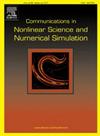A novel Cercignani–Lampis boundary model for discrete velocity methods in predicting rarefied and multi-scale flows
IF 3.4
2区 数学
Q1 MATHEMATICS, APPLIED
Communications in Nonlinear Science and Numerical Simulation
Pub Date : 2025-03-20
DOI:10.1016/j.cnsns.2025.108769
引用次数: 0
Abstract
To extend the discrete velocity method (DVM) and unified methods to more realistic boundary conditions, a Cercignani–Lampis (CL) boundary with different momentum and thermal energy accommodations is proposed and integrated into the DVM framework. By giving the macroscopic flux from the numerical quadrature of the incident molecular distribution, the reflected macroscopic flux can be obtained for the given accommodation coefficients. Then, an anisotropic Gaussian distribution can be found for the reflected molecules, whose parameters are determined by the calculated reflected macroscopic flux. These macroscopic flux and microscopic Gaussian distribution form a complete physical process for the reflected molecules. Furthermore, the CL boundary is integrated into the unified gas-kinetic scheme (UGKS), making it suitable for the simulation of both monatomic and diatomic gas flows, and it accommodates both the conventional Cartesian velocity space and the recently developed efficient unstructured velocity space. Moreover, this new GSI boundary is suitable for both explicit and implicit schemes, offering better performance for flow prediction. Finally, the performance of the new boundary is validated through a series of numerical tests covering a wide range of Knudsen and Mach numbers.
一种新的Cercignani-Lampis边界模型用于离散速度法预测稀薄和多尺度流动
为了将离散速度法(DVM)和统一方法扩展到更现实的边界条件,提出了具有不同动量和热能调节的Cercignani-Lampis (CL)边界,并将其集成到DVM框架中。通过对入射分子分布的数值求出宏观通量,可以得到在给定调节系数下反射的宏观通量。然后得到反射分子的各向异性高斯分布,其参数由计算得到的反射宏观通量确定。这些宏观通量和微观高斯分布形成了一个完整的反射分子物理过程。此外,将CL边界集成到统一气体动力学格式(UGKS)中,使其既适用于单原子气体流动的模拟,也适用于双原子气体流动的模拟,并且既适用于传统的笛卡尔速度空间,也适用于最近发展起来的高效非结构化速度空间。此外,新的GSI边界适用于显式和隐式格式,为流量预测提供了更好的性能。最后,通过一系列数值试验验证了新边界的性能,这些数值试验涵盖了广泛的克努森数和马赫数。
本文章由计算机程序翻译,如有差异,请以英文原文为准。
求助全文
约1分钟内获得全文
求助全文
来源期刊

Communications in Nonlinear Science and Numerical Simulation
MATHEMATICS, APPLIED-MATHEMATICS, INTERDISCIPLINARY APPLICATIONS
CiteScore
6.80
自引率
7.70%
发文量
378
审稿时长
78 days
期刊介绍:
The journal publishes original research findings on experimental observation, mathematical modeling, theoretical analysis and numerical simulation, for more accurate description, better prediction or novel application, of nonlinear phenomena in science and engineering. It offers a venue for researchers to make rapid exchange of ideas and techniques in nonlinear science and complexity.
The submission of manuscripts with cross-disciplinary approaches in nonlinear science and complexity is particularly encouraged.
Topics of interest:
Nonlinear differential or delay equations, Lie group analysis and asymptotic methods, Discontinuous systems, Fractals, Fractional calculus and dynamics, Nonlinear effects in quantum mechanics, Nonlinear stochastic processes, Experimental nonlinear science, Time-series and signal analysis, Computational methods and simulations in nonlinear science and engineering, Control of dynamical systems, Synchronization, Lyapunov analysis, High-dimensional chaos and turbulence, Chaos in Hamiltonian systems, Integrable systems and solitons, Collective behavior in many-body systems, Biological physics and networks, Nonlinear mechanical systems, Complex systems and complexity.
No length limitation for contributions is set, but only concisely written manuscripts are published. Brief papers are published on the basis of Rapid Communications. Discussions of previously published papers are welcome.
 求助内容:
求助内容: 应助结果提醒方式:
应助结果提醒方式:


